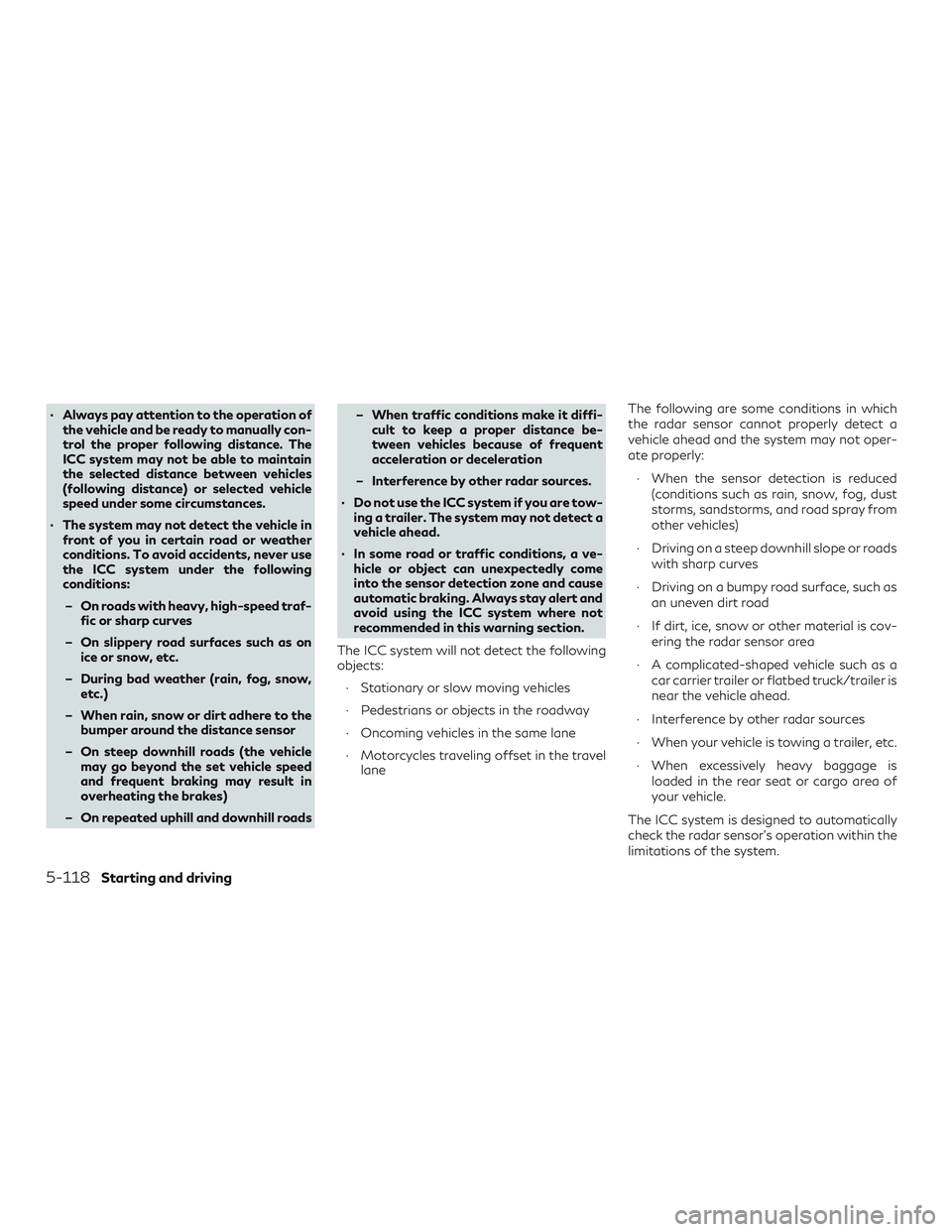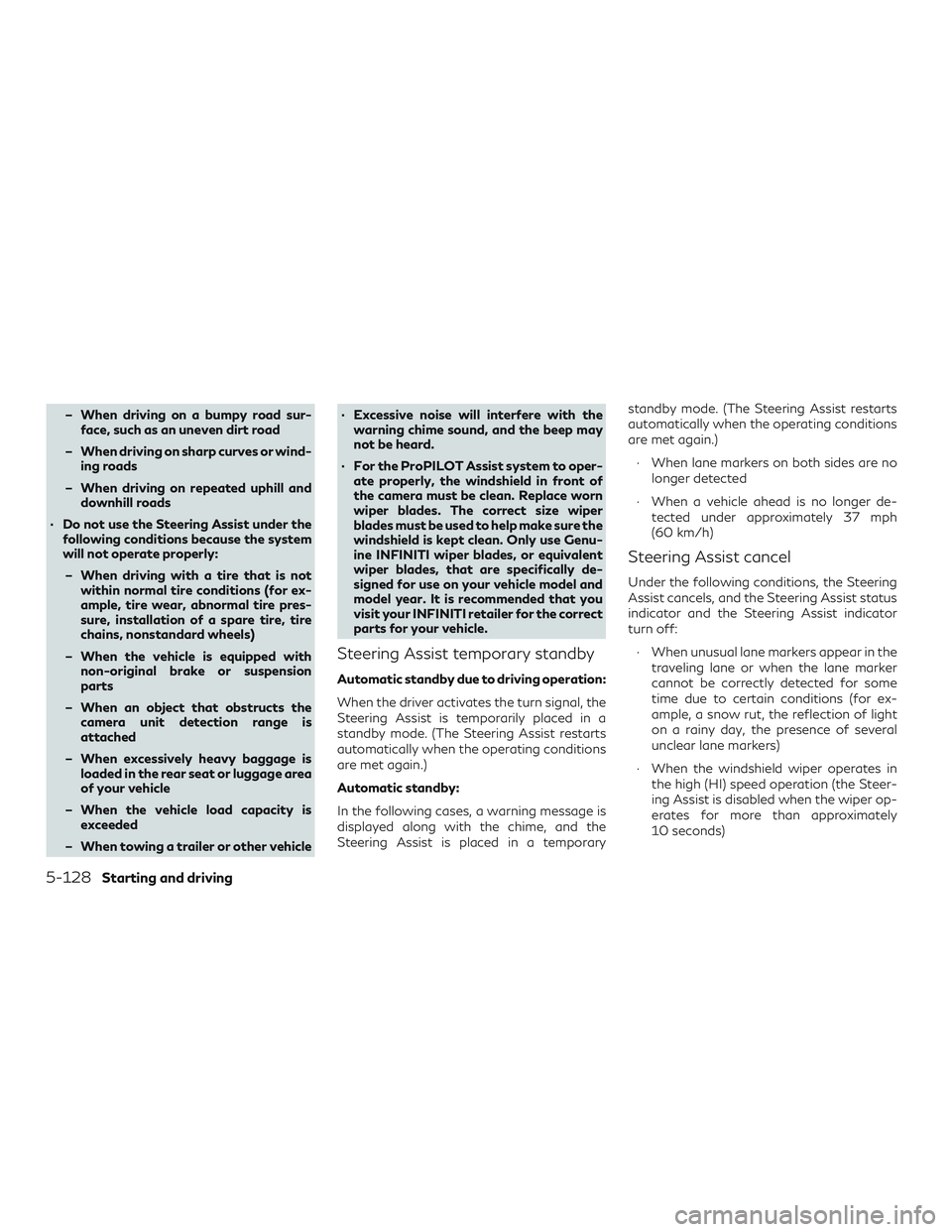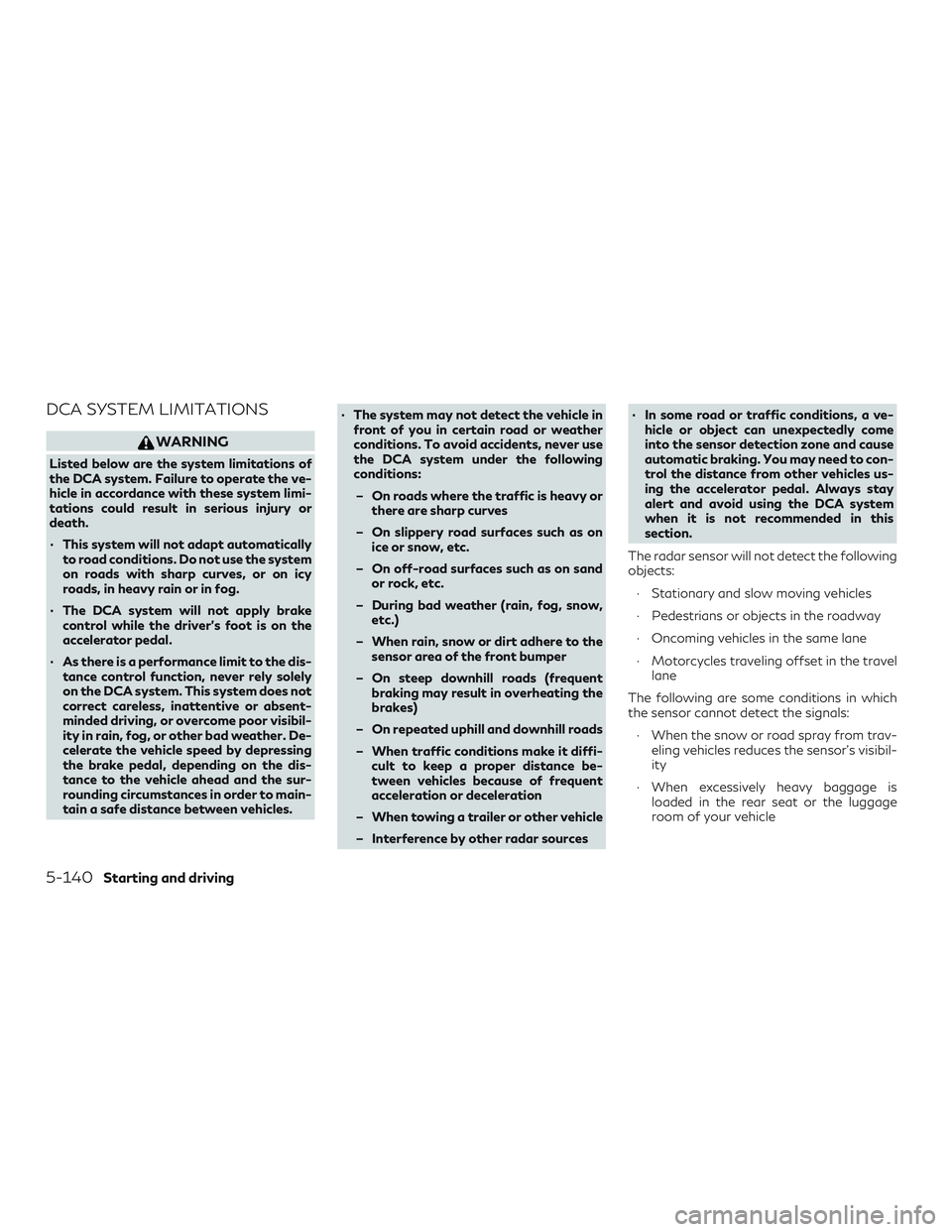towing INFINITI QX50 2020 User Guide
[x] Cancel search | Manufacturer: INFINITI, Model Year: 2020, Model line: QX50, Model: INFINITI QX50 2020Pages: 572, PDF Size: 7.29 MB
Page 372 of 572

∙ Always pay attention to the operation ofthe vehicle and be ready to manually con-
trol the proper following distance. The
ICC system may not be able to maintain
the selected distance between vehicles
(following distance) or selected vehicle
speed under some circumstances.
∙ The system may not detect the vehicle in front of you in certain road or weather
conditions. To avoid accidents, never use
the ICC system under the following
conditions:
– On roads with heavy, high-speed traf- fic or sharp curves
– On slippery road surfaces such as on ice or snow, etc.
– During bad weather (rain, fog, snow, etc.)
– When rain, snow or dirt adhere to the bumper around the distance sensor
– On steep downhill roads (the vehicle may go beyond the set vehicle speed
and frequent braking may result in
overheating the brakes)
– On repeated uphill and downhill roads – When traffic conditions make it diffi-
cult to keep a proper distance be-
tween vehicles because of frequent
acceleration or deceleration
– Interference by other radar sources.
∙ Do not use the ICC system if you are tow- ing a trailer. The system may not detect a
vehicle ahead.
∙ In some road or traffic conditions, a ve- hicle or object can unexpectedly come
into the sensor detection zone and cause
automatic braking. Always stay alert and
avoid using the ICC system where not
recommended in this warning section.
The ICC system will not detect the following
objects: ∙ Stationary or slow moving vehicles
∙ Pedestrians or objects in the roadway
∙ Oncoming vehicles in the same lane
∙ Motorcycles traveling offset in the travel lane The following are some conditions in which
the radar sensor cannot properly detect a
vehicle ahead and the system may not oper-
ate properly:
∙ When the sensor detection is reduced (conditions such as rain, snow, fog, dust
storms, sandstorms, and road spray from
other vehicles)
∙ Driving on a steep downhill slope or roads with sharp curves
∙ Driving on a bumpy road surface, such as an uneven dirt road
∙ If dirt, ice, snow or other material is cov- ering the radar sensor area
∙ A complicated-shaped vehicle such as a car carrier trailer or flatbed truck/trailer is
near the vehicle ahead.
∙ Interference by other radar sources
∙ When your vehicle is towing a trailer, etc.
∙ When excessively heavy baggage is loaded in the rear seat or cargo area of
your vehicle.
The ICC system is designed to automatically
check the radar sensor’s operation within the
limitations of the system.
5-118Starting and driving
Page 382 of 572

– When driving on a bumpy road sur-face, such as an uneven dirt road
– When driving on sharp curves or wind- ing roads
– When driving on repeated uphill and downhill roads
∙ Do not use the Steering Assist under the following conditions because the system
will not operate properly:
– When driving with a tire that is not within normal tire conditions (for ex-
ample, tire wear, abnormal tire pres-
sure, installation of a spare tire, tire
chains, nonstandard wheels)
– When the vehicle is equipped with non-original brake or suspension
parts
– When an object that obstructs the camera unit detection range is
attached
– When excessively heavy baggage is loaded in the rear seat or luggage area
of your vehicle
– When the vehicle load capacity is exceeded
– When towing a trailer or other vehicle ∙ Excessive noise will interfere with the
warning chime sound, and the beep may
not be heard.
∙ For the ProPILOT Assist system to oper- ate properly, the windshield in front of
the camera must be clean. Replace worn
wiper blades. The correct size wiper
blades must be used to help make sure the
windshield is kept clean. Only use Genu-
ine INFINITI wiper blades, or equivalent
wiper blades, that are specifically de-
signed for use on your vehicle model and
model year. It is recommended that you
visit your INFINITI retailer for the correct
parts for your vehicle.
Steering Assist temporary standby
Automatic standby due to driving operation:
When the driver activates the turn signal, the
Steering Assist is temporarily placed in a
standby mode. (The Steering Assist restarts
automatically when the operating conditions
are met again.)
Automatic standby:
In the following cases, a warning message is
displayed along with the chime, and the
Steering Assist is placed in a temporary standby mode. (The Steering Assist restarts
automatically when the operating conditions
are met again.)
∙ When lane markers on both sides are no longer detected
∙ When a vehicle ahead is no longer de- tected under approximately 37 mph
(60 km/h)
Steering Assist cancel
Under the following conditions, the Steering
Assist cancels, and the Steering Assist status
indicator and the Steering Assist indicator
turn off:
∙ When unusual lane markers appear in the traveling lane or when the lane marker
cannot be correctly detected for some
time due to certain conditions (for ex-
ample, a snow rut, the reflection of light
on a rainy day, the presence of several
unclear lane markers)
∙ When the windshield wiper operates in the high (HI) speed operation (the Steer-
ing Assist is disabled when the wiper op-
erates for more than approximately
10 seconds)
5-128Starting and driving
Page 394 of 572

DCA SYSTEM LIMITATIONS
WARNING
Listed below are the system limitations of
the DCA system. Failure to operate the ve-
hicle in accordance with these system limi-
tations could result in serious injury or
death.
∙ This system will not adapt automaticallyto road conditions. Do not use the system
on roads with sharp curves, or on icy
roads, in heavy rain or in fog.
∙ The DCA system will not apply brake control while the driver’s foot is on the
accelerator pedal.
∙ As there is a performance limit to the dis- tance control function, never rely solely
on the DCA system. This system does not
correct careless, inattentive or absent-
minded driving, or overcome poor visibil-
ity in rain, fog, or other bad weather. De-
celerate the vehicle speed by depressing
the brake pedal, depending on the dis-
tance to the vehicle ahead and the sur-
rounding circumstances in order to main-
tain a safe distance between vehicles. ∙ The system may not detect the vehicle in
front of you in certain road or weather
conditions. To avoid accidents, never use
the DCA system under the following
conditions:
– On roads where the traffic is heavy or there are sharp curves
– On slippery road surfaces such as on ice or snow, etc.
– On off-road surfaces such as on sand or rock, etc.
– During bad weather (rain, fog, snow, etc.)
– When rain, snow or dirt adhere to the sensor area of the front bumper
– On steep downhill roads (frequent braking may result in overheating the
brakes)
– On repeated uphill and downhill roads
– When traffic conditions make it diffi- cult to keep a proper distance be-
tween vehicles because of frequent
acceleration or deceleration
– When towing a trailer or other vehicle
– Interference by other radar sources ∙ In some road or traffic conditions, a ve-
hicle or object can unexpectedly come
into the sensor detection zone and cause
automatic braking. You may need to con-
trol the distance from other vehicles us-
ing the accelerator pedal. Always stay
alert and avoid using the DCA system
when it is not recommended in this
section.
The radar sensor will not detect the following
objects: ∙ Stationary and slow moving vehicles
∙ Pedestrians or objects in the roadway
∙ Oncoming vehicles in the same lane
∙ Motorcycles traveling offset in the travel lane
The following are some conditions in which
the sensor cannot detect the signals: ∙ When the snow or road spray from trav- eling vehicles reduces the sensor’s visibil-
ity
∙ When excessively heavy baggage is loaded in the rear seat or the luggage
room of your vehicle
5-140Starting and driving
Page 449 of 572

6 In case of emergency
Hazard warning flasher switch....................6-2
Roadside assistance program .....................6-2
Emergency engine shut off .......................6-3
Flat tire ..........................................6-3
Tire Pressure Monitoring System (TPMS) .......6-3
Run-flat tires ..................................6-4 Jump starting
....................................6-5
Push starting .....................................6-7
If your vehicle overheats ..........................6-7
Towing your vehicle ..............................6-8
Towing recommended by INFINITI .............6-8
Vehicle recovery (freeing a stuck vehicle) ......6-11
Page 456 of 572

6. After the engine cools down, check thecoolant level in the engine coolant reser-
voir tank with the engine running. Add
coolant to the engine coolant reservoir
tank if necessary. Have your vehicle re-
paired. It is recommended that you visit
an INFINITI retailer for this service. When towing your vehicle, all jurisdictions
and local regulations for towing must be fol-
lowed. Incorrect towing equipment could
damage your vehicle. Towing instructions are
available from an INFINITI retailer. Local ser-
vice operators are generally familiar with the
applicable laws and procedures for towing.
To assure proper towing and to prevent ac-
cidental damage to your vehicle, INFINITI
recommends having a service operator tow
your vehicle. It is advisable to have the service
operator carefully read the following precau-
tions:
WARNING
∙ Never ride in a vehicle that is being
towed.
∙ Never get under your vehicle after it has been lifted by a tow truck.
CAUTION
∙ When towing, make sure that the trans-mission, axles, steering system and pow-
ertrain are in working condition. If any of
these conditions apply, dollies or a flat-
bed tow truck must be used.
∙ Always attach safety chains before towing. For additional information, refer to “Flat
towing” in the “Technical and consumer infor-
mation” section of this manual.
TOWING RECOMMENDED BY
INFINITI
INFINITI recommends towing your vehicle
based upon the type of drivetrain. For addi-
tional information, refer to the diagrams in
this section to ensure that your vehicle is
properly towed.
TOWING YOUR VEHICLE
6-8In case of emergency
Page 457 of 572

All-Wheel Drive (AWD) models with
Continuously Variable Transmission
(CVT)
INFINITI recommends that towing dollies be
used when towing your vehicle or place the
vehicle on a flatbed truck as illustrated.
CAUTION
Never tow AWD models equipped with a
Continuously Variable Transmission (CVT)
with any of the wheels on the ground as this
may cause serious and expensive damage to
the transfer case and transmission.
LCE2370
In case of emergency6-9
Page 458 of 572

Two-Wheel Drive models with
Continuously Variable Transmission
(CVT)
INFINITI recommends that your vehicle be
towed with the driving (front) wheels off the
ground or place the vehicle on a flatbed truck
as illustrated.NOTE:
If the electronic parking brake is released,
the rear wheels can be grounded while tow-
ing. If the electronic parking brake is not re-
leased, towing dollies should be used. For
additional information, refer to “Electronic
parking brake” in the “Starting and driving”
section of this manual.
CAUTION
∙ Never tow Continuously Variable Trans-
mission (CVT) models with the front
wheels on the ground or four wheels on
the ground (forward or backward), as
this may cause serious and expensive
damage to the transmission. If it is neces-
sary to tow the vehicle with the rear
wheels raised always use towing dollies
under the front wheels.
∙ When towing Continuously Variable Transmission (CVT) models with the rear
wheels on the ground or on towing
dollies:
– Place the ignition switch in the OFF position, and secure the steering
wheel in a straight-ahead position
with a rope or similar device. Never
secure the steering wheel by placing
the ignition switch in the LOCK posi-
tion. This may damage the steering
lock mechanism (for models with a
steering lock mechanism).
LCE2371
6-10In case of emergency
Page 459 of 572

VEHICLE RECOVERY (freeing a
stuck vehicle)
WARNING
To avoid vehicle damage, serious personal
injury or death when recovering a stuck
vehicle:
∙ Contact a professional towing service torecover the vehicle if you have any ques-
tions regarding the recovery procedure.
∙ Tow chains or cables must be attached only to main structural members of the
vehicle.
∙ Do not use the vehicle tie-downs to tow or free a stuck vehicle.
∙ Only use devices specifically designed for vehicle recovery and follow the manufac-
turer’s instructions.
∙ Always pull the recovery device straight out from the front of the vehicle. Never
pull at an angle.
∙ Route recovery devices so they do not touch any part of the vehicle except the
attachment point. If your vehicle is stuck in sand, snow, mud,
etc., use a tow strap or other device designed
specifically for vehicle recovery. Always fol-
low the manufacturer’s instructions for the
recovery device.Rocking a stuck vehicle
WARNING
∙ Stand clear of a stuck vehicle.
∙ Do not spin your tires at high speed. This
could cause them to explode and result in
serious injury. Parts of your vehicle could
also overheat and be damaged.
If your vehicle is stuck in sand, snow, mud,
etc., use the following procedure: 1. Turn off the Vehicle Dynamic Control (VDC) system.
2. Make sure the area in front and behind the vehicle is clear of obstructions.
3. Turn the steering wheel right and left to clear an area around the front tires.
4. Slowly rock the vehicle forward and backward.
∙ Shift back and forth between R (Re- verse) and D (Drive). ∙ Apply the accelerator as little as pos-
sible to maintain the rocking motion.
∙ Release the accelerator pedal before shifting between R (Reverse) and D
(Drive).
∙ Do not spin the tires above 35 mph (55 km/h).
5. If the vehicle cannot be freed after a few tries, contact a professional towing ser-
vice to remove the vehicle.
In case of emergency6-11
Page 513 of 572

To help ensure smooth, safe and economical
driving, INFINITI provides two maintenance
schedules that may be used, depending upon
the conditions in which you usually drive.
These schedules contain both distance and
time intervals, up to 90,000 miles
(144,000 km)/144 months. For most
people, the odometer reading will indicate
when service is needed. However, if you drive
very little, your vehicle should be serviced at
the regular time intervals shown in the sched-
ule.
After 90,000 miles (144,000 km)/144 months,
continue maintenance at the same mileage/time
intervals.
ADDITIONAL MAINTENANCE
ITEMS FOR SEVERE OPERATING
CONDITIONS
Additional maintenance items for severe op-
erating conditionsshould be performed on
vehicles that are driven under especially de-
manding conditions. Additional maintenance
items should be performed if you primarily
operate your vehicle under the following con-
ditions:
∙ Repeated short trips of less than 5 miles (8 km). ∙ Repeated short trips of less than 10 miles
(16 km) with outside temperatures re-
maining below freezing.
∙ Operating in hot weather in stop-and-go “rush hour” traffic.
∙ Extensive idling and/or low speed driving for long distances, such as police, taxi or
door-to-door delivery use.
∙ Driving in dusty conditions.
∙ Driving on rough, muddy or salt spread roads.
∙ Towing a trailer, using a camper or using a car-top carrier.
OIL CONTROL SYSTEM
Your vehicle is equipped with oil control sys-
tem. It calculates engine oil and filter change
intervals based on driving conditions. Driving
in the following severe conditions will shorten
the engine oil and filter change interval.
MAINTENANCE SCHEDULES
Maintenance and schedules9-7
Page 514 of 572

How driving conditions affect OCS display
timing
ConditionsDriving Scene Display timing
Light ∙ Freeway driving
∙ City driving (flat/moderate hills)
∙ No towing or heavy loads
∙ No extended engine idling Normal
Extreme ∙ Repeated short trips of less than 5 miles (8 km).
∙ Repeated short trips of less than 10 miles (16 km) with outside temperatures remaining below
freezing.
∙ Operating in hot weather in stop-and-go “rush hour” traffic.
∙ Extensive idling and/or low speed driving for long distances, such as police, taxi or door-to-
door delivery use.
∙ Towing a trailer or caravan, or using a car-top carrier.
∙ Driving with frequent use of braking or in mountainous areas.
∙ Sustained high speed driving. Early
CAUTION
∙ If the oil replacement indicator is dis-
played, change the engine oil within two
weeks or less than 500 miles (800 km).
∙ Operating your vehicle with deteriorated oil can damage the engine.
∙ If your oil replacement indicator resets prematurely or becomes inoperative,
please change the oil within six months or
3,750 miles (6,000 km) from your last oil
change.
9-8Maintenance and schedules